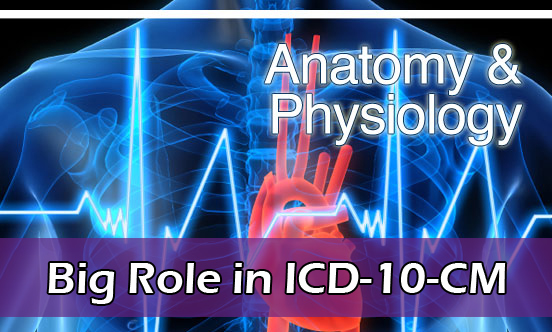Many coders ask why it is necessary to study anatomy and physiology to prepare for ICD-10-CM. After all, they have always chosen their codes based on a provider’s documentation and everything they have been trained in thus far, proves maneuvering within the pages of the ICD 10 CM Coding manual is similar to ICD-9-CM.
The truth is however, many coders have been trained on the job with minimal knowledge of how an ICD-9-CM manual works; and many coders have had no formal training in Anatomy & Physiology. So why is this suddenly an issue? In ICD-10-CM, specificity has become crucial to accurate coding. Coders have to be aware of what a provider documents and often must derive a clinical conclusion from the provider’s notes. How can a coder understand the documentation if he or she doesn’t know if the femur is in the arm or the leg- upper or lower limb? What if a patient is having a common wart removed from his left calcaneus? What if the doctor indicated he removed a common wart from the left tarsal bone, which in humans is the large bone of the heel, otherwise known as the calcaneus? As a coder, you should understand the anatomy and be able to cross reference both terms.
Plays a Big Role in ICD 10 CM Coding
Let’s say a provider is treating a patient for diabetes with mild nonproliferative diabetic retinopathy with “retinal edema”. A coder who is proficient in anatomy and physiology will know we are dealing with a systemic disease (diabetes) as well as a complication involving the eye. The first thing she must determine is the type of diabetes the patient has. If the provider does not specify the type of diabetes, the coder will use the default code which is Type 2. In this particular documentation, a coder who is trained in A & P will understand the terminology, the disease process, as well as how the diabetes affected the eye. She will know that mild nonproliferative retinopathy is the earliest stage of a retinal disorder where small balloon-like swelling occurs in the small vessels of the retina. She will also know the retina is an important anatomical component of the eye. Now the provider may write the same description as above but instead of indicating “retinal edema”, he may indicate “macular edema”. A coder educated in A & P will know that the code for Type 2 diabetes with mild nonproliferative diabetic retinopathy with macular or retinal edema is E11.321. Why? Because the macula is located in the center of the retina and both terms are interchangeable in ICD-10-CM.
Learning Anatomy and Physiology will definitely help you become a better coder. Whether you need a brush up course or are starting from scratch, the program in CCO is comprehensive and worth the investment. Visit www. and see how their curriculum fits your needs.
Read Related Content about ICD 10 CM Coding
ICD 10 Certification – ICD 10 CM Proficiency Exam – Video
AAPC – ICD-10 Coding
![[CCO] Certification Coaching Organization LLC [CCO] Certification Coaching Organization LLC](https://www.cco.us/wp-content/uploads/2015/05/CCO-Logo-2015-d3-500px.png)

